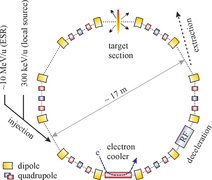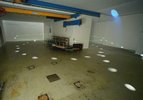CRYRING@ESR
CRYRING@ESR is low-energy storage ring for heavy ions and is integrated into the GSI accelerator complex and the smallest of the storage rings here. All ion species, which are available as beams at the GSI accelerator complex can be transported to and stored in CRYRING@ESR for experiments in the fields of atomic or nuclear physics, materials research and beyond. The SPARC, BioMat, FLAIR, and NuSTAR collaborations of FAIR have formulated a rich research program. Moreover, the machine provided a highly accessible test platform for novel FAIR technologies.
Formerly, CRYRING was located at the Manne Siegbahn Laboratory at Stockholm University, Sweden, where it operated for almost to two decades and allowed for many significant scientific contributions to atomic and molecular physics. Integrating CRYRING into the GSI/FAIR setup has for long been proposed. The machine is the first facility realized in the FAIR project and implemented In cooperation with Swedish partners and further international contributors. At it's new home in Darmstadt, CRYRING@ESR gained access to new classes of ion species which were previously out of reach in Stockholm, such as highly charged ions, exotic isotopes, and in the future possibly even antiprotons. In Darmstadt, the ring was modernized and adapted to the GSI/FAIR standards and set up downstream of ESR (Report).

CRYRING@ESR can store, cool and decelerate heavy, highly charged ions down to a few 100 keV/nucleon. It features excellent vacuum conditions to achieve ion beam lifetimes of several seconds to minutes for even the highest charge states of ions. It is equipped with an electron cooler, as well as with a gas-jet target. Moreover, an independent injector beamline will allow for standalone operation during commissioning and prototyping while the FAIR accelerators are unavailable.
The ions are kept in orbit by twelve 30° magnetic dipoles and a number of magnetic quadrupoles and sextupoles (not shown in the figure) in six of the twelve straight sections. The other six sections implement the injection system, the beam extraction, beam diagnostics, an rf-gap for de- or acceleration, and the electron cooler. Finally, one section is available for experimental installations as for instance a gas target.
Circumference | 54.17 m (ESR/2) |
Rigidity | 0.054 – 1.44 Tm (– 0.8 Tm for protons/antiprotons) |
Maximum energy for p, pbar | 30 MeV |
- for 12C6+ | 24.7 MeV/u |
- for 238U92+ (238U89+) | 14.8 MeV/u (13.9 MeV/u) |
Lowest energy | Charge exchange limited |
Magnet ramping (de- and acceleration) | 1 T/s (4 T/s, 7 T/s) |
Vacuum pressure | N2 equiv. 10-12 – 10-11 mbar |
Beam injection | Multiturn and fast |
Beam extraction | slow and fast |
Ion source for stand alone operation | Yes (300 keV/u, A/q < 2.85) |
The new FAIR-type control system has been first deployed to CRYRING@ESR and provided operation under real beam conditions. CRYRING@ESR hence provided important feedback on user experience, tested the interplay of the newly implemented tools and concepts and also on scrutinizing on the stability of the system. The new FAIR-type system is now being rolled out to the other machines of GSI and FAIR. Moreover, with the local ion source the ring can also be operated independently. This makes it a perfect training environment for the operators crew to get accommodated with the new control system. Both allow for valuable feedback on the operational concept well in advance before the commissioning of FAIRs key machines are taken into service.
Status
CRYRING@ESR is in operation and beam transfer from ESR to CRYRING is available. Ion storage with beam from the local source has been achieved Sep. 2017, transfer and storage of ions from ESR was established in Dec. 2019. The machine is regularly providing beamtime for G-PAC approved proposals since 2021. Moreover, the local ion source provides a range of light ions from gaseous and solid sample materials. The source transmits beams through a 300 keV/u RFQ accelerator to the ring. The ion beam energy can be ramped up to maximum rigidity or ramped down to the low-energy limit. The beam lifetime is limited only by the prevailing vacuum conditions.

Stored ions in CRYRING@ESR
Ion | Energy (MeV/u) | Stored particle number | Lifetime (s) | Source + Injector |
|---|---|---|---|---|
H2+ | 0.3 → 24 | ~108 | 5.4 | MINIS + RFQ |
D+ | 0.3 - 16 | 107 | ~60 - 6000 (@ 7x10-11 mbar) | MINIS + RFQ |
C+ | 0.003 → 0.69 | ~5×106 | 5 | MINIS |
Li+ | 0.005 → 2 | ~107 | 9 | MINIS |
N+ | 0.002 → 0.42 | 8×107 | ~5 | ECR |
N5+ | 0.3 → 1.125 | 1×107 | ~60 | ECR + RFQ |
O6+ | 0.3 → 10 | 5×105 | 250 | ECR + RFQ |
Ne2+ | 0.003 → 1 | 107 | 18 | ECR |
Ne3+ | 0.005 → 2.25 | 5×106 | 8 | ECR |
Ne7+ | 0.3 → 4 | 7×106 | 80 | ECR + RFQ |
S3+ | 0.003 → 0.88 | 5×106 | ~18 | ECR |
Mg+ | 0.001 → 0.032 |
| 7 | MINIS |
Ar+ | 0.001 → 0.016 |
|
| MINIS |
Ar18+ | 13 | ~106 | ~600 | ESR |
Au75+ | 12 | 5×106 | ~30 | ESR |
Au78+ | 10 | ~3×106 | 24 | ESR |
Pb78+ | 4 - 10 | 104 | 8-28 | ESR |
U91+ | 10 | 2×106 | 20 | ESR |
Collaboration
The CRYRING@ESR project was realized with strong support from many technical expert groups at GSI, the Atomic, Quantum & Fundamental Physics department, APPA-R&D and the SPARC collaboration and in particular from its international collaboration partners. Their efforts are kindly acknowledged:
Research at CRYRING is coordinated through the 'Decelerator Experiments' group (DEX) in the Atomic, Quantum & Fundamental Physics department in close cooperation with SPARC.
Documents and publications
- TDR: Low energy Storage Ring LSR, Stockholm 2011
- CRYRING@ESR: A study group report, Darmstadt 2012
- Physics book: CRYRING@ESR, Eur. Phys. J. Spec. Top. (2016) 225:797
- TDR: Experimental Instrumentation of CRYRING@ESR, Darmstadt 2016
- GSI Annual report: 2021, 2020, 2019, 2018, 2017, 2016, 2015, 2014, 2013, 2012,
- Browse publications database (GSI repository)





